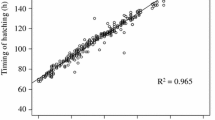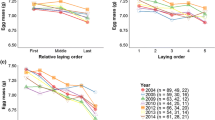Abstract
Reviews of hatching asynchrony in birds recommended more studies on intraspecific variation in the extent of hatching asynchrony. We examined intraspecific variation in clutch size, laying chronology, onset of incubation, incubation period, and hatching asynchrony in burrowing owls (Athene cunicularia) in the Imperial Valley of California. Mean clutch size was 7.4 eggs and owls averaged 0.5 eggs laid per day. Females varied considerably in laying interval and onset of incubation (range = 1st to 9th egg in the clutch). The mean incubation period was 21.9 days. Hatching interval also varied greatly among females (\( \overline{x} \) = 0.8, range 0.1–2.0 days between successively hatched eggs). Past burrowing owl studies have largely overlooked the substantial intraspecific variation in these traits or have reported estimates that differ from ours. Future studies designed to identify the environmental factors that explain the large intraspecific variation in these traits will likely provide insights into the constraints on local abundance.
Similar content being viewed by others
References
Ardia DR, Cooper CB, Dhondt AA (2006) Warm temperatures lead to early onset of incubation, shorter incubation periods and greater hatching asynchrony in tree swallows, Tachycineta bicolor, at the extremes of their range. J Avian Biol 37:137–142
Astheimer LB (1985) Long laying intervals: a possible mechanism and its implications. Auk 102:401–409
Beissinger SR, Waltman JR (1991) Extraordinary clutch size and hatching asynchrony of a neotropical parrot. Auk 108:863–871
Boal C (2001) Nonrandom mating and productivity of adult and subadult cooper’s hawks. Condor 103:381–385
Bortolotti GR, Wiebe KL (1993) Incubation behaviour and hatching patterns in the American kestrel Falco sparverius. Ornis Scand 24:41–47
Catlin D, Rosenberg DK (2008) Breeding dispersal and nesting behaviors of burrowing owls following experimental nest predation. Am Midl Nat 159:1–7
Clark AB, Wilson DS (1981) Avian breeding adaptations: hatching asynchrony, brood reduction, and nest failure. Q Rev Biol 56:253–277
Conway CJ, Pardieck KL (2006) Population trajectory of burrowing owls in eastern Washington. Northwest Sci 80:292–297
Coulombe HN (1971) Behavior and population ecology of the burrowing owl, Speotyto cunicularia, in the Imperial Valley of California. Condor 73:162–176
Decker K, Conway CJ, Fontaine JJ (2012) Nest predation, food, and female age explain seasonal declines in clutch size. Evol Ecol 26:683–699
DeSante DF, Ruhlen ED, Rosenberg DK (2004) Density and abundance of burrowing owls in the agricultural matrix of the Imperial Valley, California. Stud Avian Biol 27:116–119
Dinsmore SJ, White GC, Knopf FL (2002) Advanced techniques for modeling avian nest survival. Ecology 83:3476–3488
Drent RH, Daan S (1980) The prudent parent: energetic adjustments in avian breeding. Ardea 68:225–252
Garcia V, Conway CJ (2009) What constitutes a nesting attempt? Variation in criteria causes bias and hinders comparisons across studies. Auk 126:31–40
Haug EA (1985) Observations on the breeding ecology of burrowing owls in Saskatchewan [thesis]. University of Saskatchewan, Saskatoon
Haug EA, Millsap BA, Martell MS (1993) Burrowing owl (Athene cunicularia). In: Poole A, Gill F (eds) The birds of North America. The Academy of Natural Sciences, Philadelphia, PA and American Ornithologists’ Union, Washington, DC
Henny CJ, Blus LJ (1981) Artificial burrows provide new insight into burrowing owl nesting biology. J Raptor Res 15:82–85
Holroyd GL, Rodriguez-Estrella R, Sheffield SR (2001) Conservation of the burrowing owl in western North America: issues, challenges and recommendations. J Raptor Res 35:399–407
Hsu Y, Li S, Lin Y, Philippart MT, Severinghaus LL (2006) High frequency of extra-pair copulation with low level of extra-pair fertilization in the Lanyu scops owl Otus elegans botelensis. J Avian Biol 37:36–40
Hussell DJT (1972) Factors affecting clutch size in arctic passerines. Ecol Monogr 42:317–364
James PC, Espie RHM (1997) Current status of the burrowing owl in North America: an agency survey. J Raptor Res 9:3–5
Kim M, Furness RW, Nager RG (2010) Hatching asynchrony is constrained by parental nest attendance during laying. Behav Ecol Sociobiol 64:1087–1097
Klute DS, Ayers LW, Green MT, Howe WH, Jones SL, Shaffer JA, Sheffield SR, Zimmerman TS (2003) Status assessment and conservation plan for the western burrowing owl in the United States. U.S. Department of Interior, Fish and Wildlife Service, Biological Technical Publication FWS/BTP-R6001-2003, Washington, D.C.
Kontiainen P, Pietiainen H, Karell P, Pihlaja T, Brommer JE (2010) Hatching asynchrony is an individual property of female Ural owls which improves nestling survival. Behav Ecol 21:722–729
Landry RE (1979) Growth and development of the burrowing owl (Athene cunicularia) [thesis]. California State University, Long Beach
Lantz S, Conway CJ (2009) Factors affecting daily nest survival of burrowing owls within black-tailed prairie dog colonies. J Wildl Manag 73:232–241
Magrath RD (1990) Hatching asynchrony in altricial birds. Biol Rev 65:587–622
Mayfield HF (1961) Nesting success calculated from exposure. Wilson Bull 73:255–261
Mayfield HF (1975) Suggestions for calculating nest success. Wilson Bull 87:456–466
Newton I (1976) Breeding of sparrowhawks (Accipiter nisus) in different environments. J Anim Ecol 45:831–849
Newton I, Marquiss M (1984) Seasonal trend in the breeding performance of sparrowhawks. J Anim Ecol 53:809–829
Newton I, Marquiss M, Village A (1983) Weights, breeding and survival in European sparrowhawks. Auk 100:344–354
Nilsson JA (1995) Parent-offspring interaction over brood size: cooperation or conflict? J Avian Biol 26:255–259
Olenick BE (1990) Breeding biology of burrowing owls using artificial nest burrows in southeastern Idaho [thesis]. Idaho State University, Pocatello
Pietiainen H (1989) Seasonal and individual variation in the production of offspring in the Ural owl Strix uralensis. J Anim Ecol 58:905–920
Porter SN, Wiemeyer N (1972) Reproductive patterns in captive American kestrels (sparrow hawks). Condor 74:46–53
Ricklefs RE (1993) Sibling competition, hatching asynchrony, incubation period, and lifespan in altricial birds. In: Power DM (ed) Current ornithology, vol 11. Plenum Press, New York, pp 199–276
Ricklefs RE (1997) Hatching asynchrony in birds. Trends Ecol Evol 12:229
Rosenberg DK, Haley KL (2004) The ecology of burrowing owls in the agroecosystem of the Imperial Valley, California. Stud Avian Biol 27:120–135
Sheffield SR (1997) Current status, distribution, and conservation of the burrowing owl (Speotyto cunicularia) in Midwestern and western North America. In: Duncan JR, Johnson DH, Nicholls TH (eds) Biology and conservation of owls of the northern hemisphere, second international symposium. U.S. Forest Service General Technical Report NC-GTR-190, North Central Forest Experiment Station St. Paul, MN, pp 399–407
Slagsvold T, Lifjeld JT (1989) Constraints on hatching asynchrony and egg size in pied flycatchers. J Anim Ecol 58:837–845
Slagsvold T, Husby M, Sandvik J (1992) Growth and sex ratio in two species of crows: how important is hatching asynchrony? Oecologia 90:43–49
Stenning MJ (1996) Hatching asynchrony, brood reduction and other rapidly reproducing hypotheses. Trends Ecol Evol 11:243–246
Stoleson SH, Beissinger SR (1995) Hatching asynchrony and the onset of incubation in birds, revisited: when is the critical period? In: Power DM (ed) Current ornithology, vol 12. Plenum Press, New York, pp 191–270
Stoleson SH, Beissinger SR (1999) Egg viability as a constraint on hatching asynchrony at high ambient temperatures. J Anim Ecol 68:951–962
Szollosi E, Rosivall B, Torok J (2007) Is hatching asynchrony beneficial for the brood? Behav Ecol 18:420–426
Thomsen L (1971) Behavior and ecology of burrowing owls on the Oakland Municipal Airport. Condor 73:177–192
Veiga JP, Viñuela J (1993) Hatching asynchrony and hatching success in the house sparrow: evidence for the egg viability hypothesis. Ornis Scand 24:237–242
Viñuela J (1997) Laying order affects incubation duration in black kites (Milvus migrans): counteracting hatching asynchrony? Auk 114:192–199
Wang JM, Beissinger SR (2009) Variation in the onset of incubation and its influence on avian hatching success and asynchrony. Anim Behav 78:601–613
Wellicome TI (2000) Effects of food on reproduction in burrowing owls (Athene cunicularia) during three stages of the breeding season [dissertation]. University of Alberta, Calgary
Wellicome TI (2005) Hatching asynchrony in burrowing owls is influenced by clutch size and hatching success but not by food. Oecologia 142:326–334
Wellicome TI, Holroyd GL (2001) The second international burrowing owl symposium: background and context. J Raptor Res 35:269–273
Wiebe KL (1995) Intraspecific variation in hatching asynchrony: should birds manipulate hatching spans according to food supply? Oikos 74:453–462
Zarn M (1974) Habitat management series for unique or endangered species. Bureau of Land Management Technical note T-N-250, Denver Service Center, Bldg. 50, DFC-Denver, CO
Acknowledgments
The Sonny Bono Salton Sea National Wildlife Refuge provided housing and logistical support and A. Kalin facilitated our work on private lands. Many technicians assisted with data collection, especially N. Bartok and J. Mohlmann.
Author information
Authors and Affiliations
Corresponding author
About this article
Cite this article
Conway, M., Nadeau, C.P. & Conway, C.J. Intraspecific variation in reproductive traits of burrowing owls. J Ethol 30, 395–402 (2012). https://doi.org/10.1007/s10164-012-0337-x
Received:
Accepted:
Published:
Issue Date:
DOI: https://doi.org/10.1007/s10164-012-0337-x




